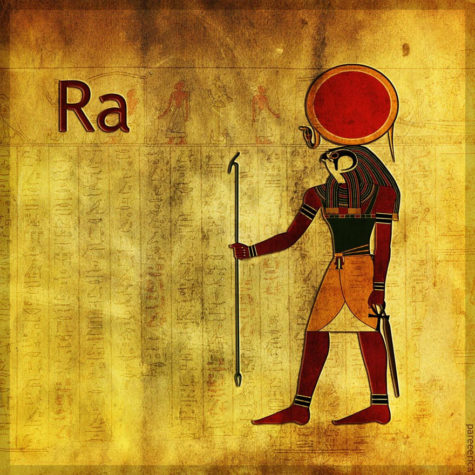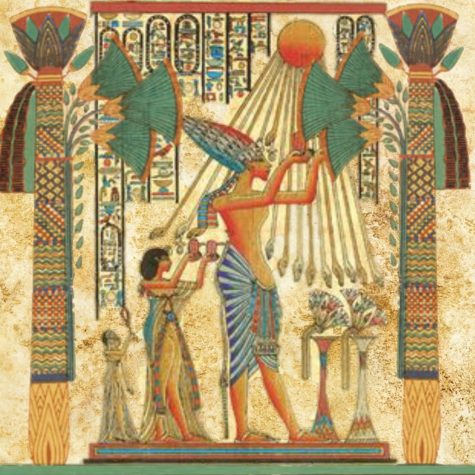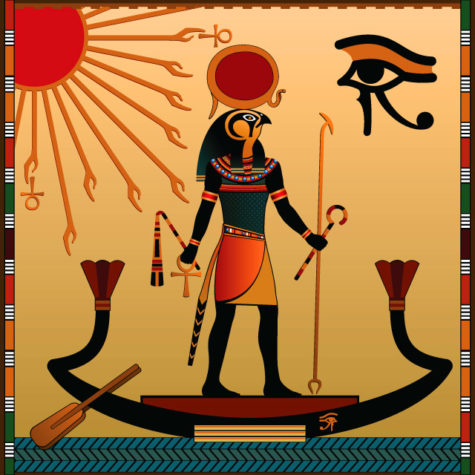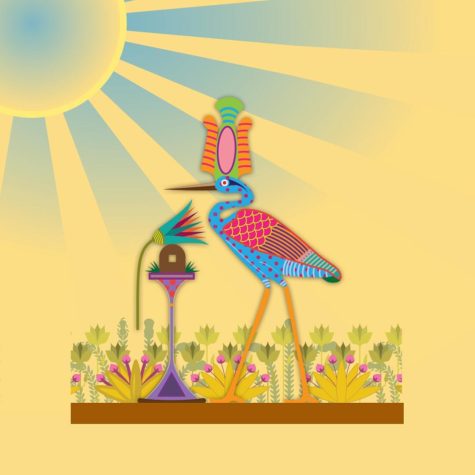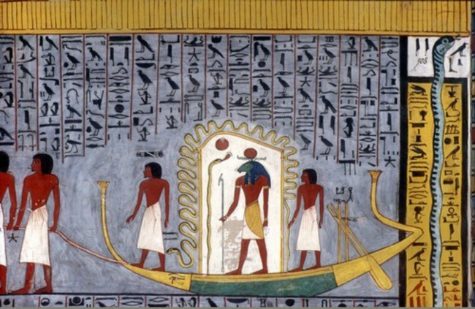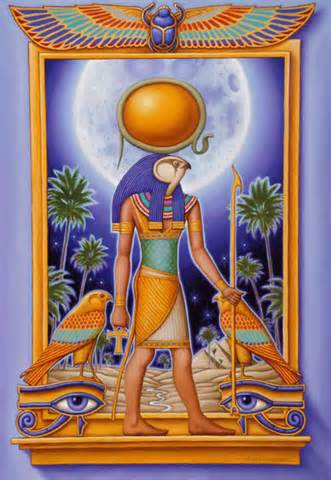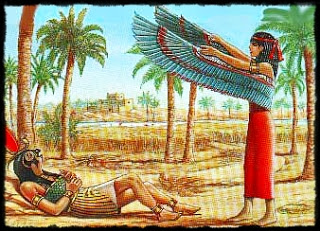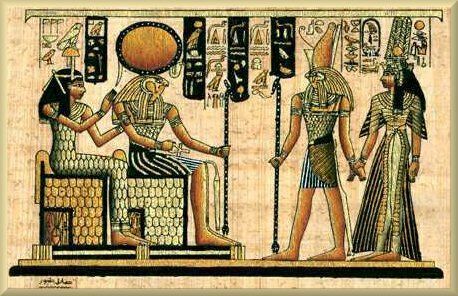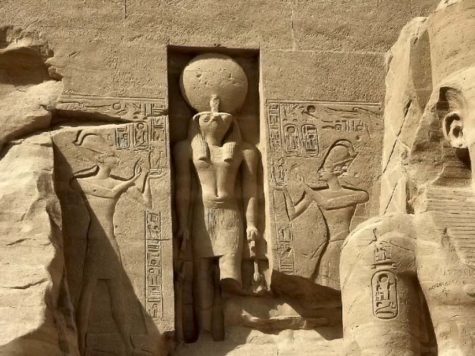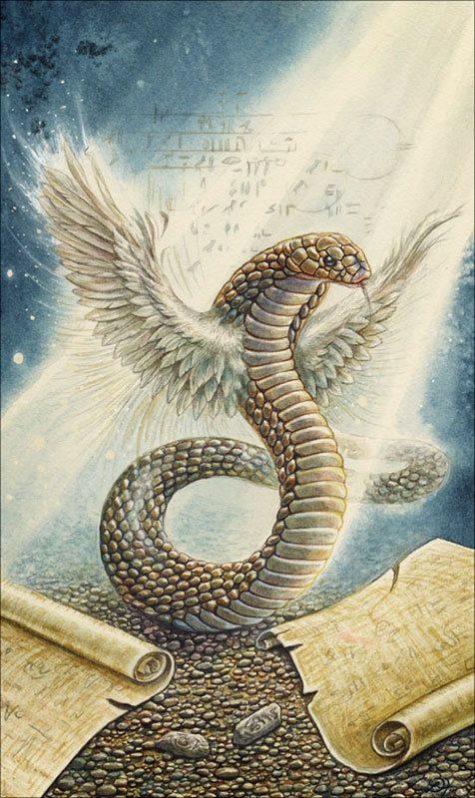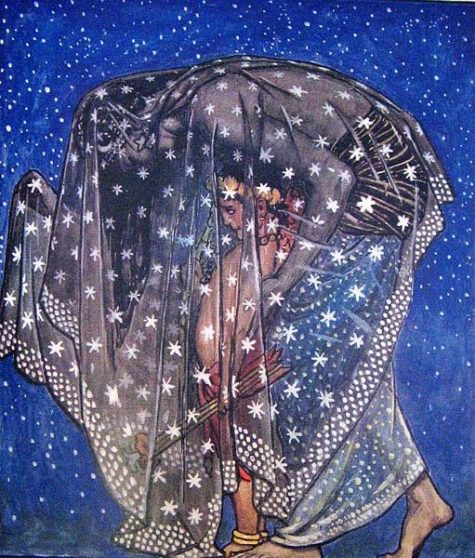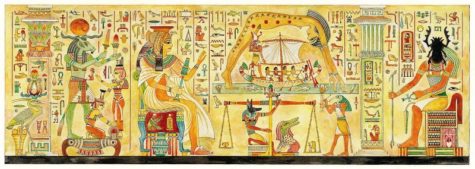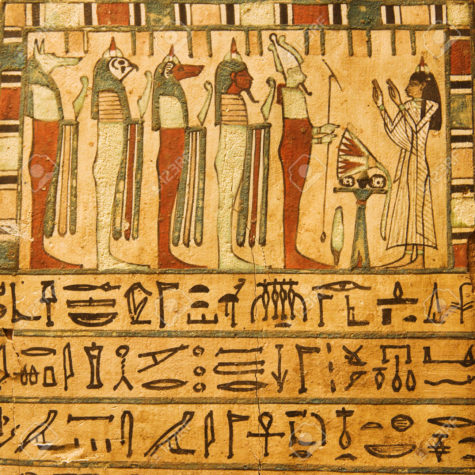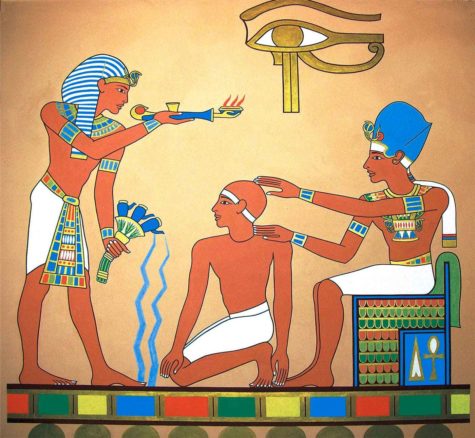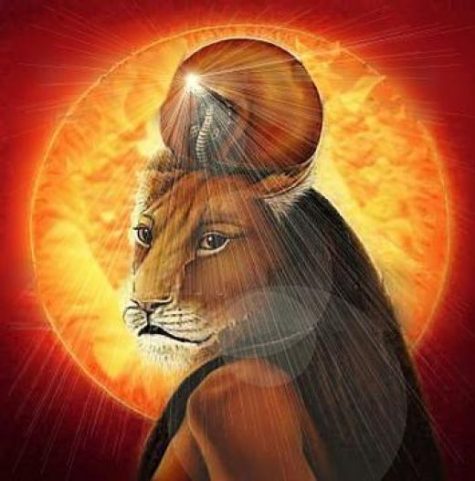Egyptian Gods and Goddesses
Ra (pronounced as Rah, and sometimes as Ray) is an ancient Egyptian sun god. By the fifth dynasty he became a major deity in ancient Egyptian religion, identified primarily with the mid-day sun, with other deities representing other positions of the sun. Ra changed greatly over time and in one form or another, much later he was said to represent the sun at all times of the day.
Also known as:
- Re
- Phra
- Amun-Ra
- Akmun-Ra
Ra should be pronounced as ‘rei’; hence the alternative spelling Re rather than Ra. The meaning of Ra’s name is uncertain, but it is thought if not a word for ‘sun’ it may be a variant of or linked to ‘creative’. As his cult arose in the Egyptian pantheon, Ra often replaced Atum as the father, grandfather, and great-grandfather of the deities of the Ennead, and became a creator of the world.
Ra was an incredibly powerful and important central god of the Egyptian pantheon. His believers considered him to be the god who created everything. He was worshiped more than any other god by the ancient Egyptians.
Ra represents sunlight, warmth and growth. It was only natural that the ancient Egyptians would believe him to be the creator of the world, as well as part of him being represented in every other god. The ancient Egyptians believed that every god should illustrate some aspect of him, while Ra himself should also represent every god.
Ra created himself from the primordial chaos. He is also known as Re and Atum. His children are Shu, the God of Dry Air and Father of the Sky, and his twin sister Tefnut, the Goddess of Moisture and Wetness. Humans were created from Ra’s tears.
Invoked For:
He is the source of all light and life, destroyer of darkness, night, wickedness, evil. Creator of Heaven, Earth, and the Underworld. Eternal god without end. God of all agriculture, the Sun, magick, prosperity, spells, rituals, destiny, right, and truth.
Sun Ra Invocation:
As the sun pierces your consciousness and you struggle through those dog days of summer, it becomes easy to understand the ancient Egyptian respect for the Sun God. Pay tribute to Ra for his blessings in the way he likes best. In ancient Egypt, myrrh was burned at high noon to please him.
Put a few small chunks of myrrh on a white charcoal block placed on a fireproof surface outdoors. Use your hands to gently brush the smoke upward toward the heavens as you chant:
In honor and praise I send this smoke toward you
Thanks for the blessings and the sunny days, too
Sun Ra, great god, emblem of the sun
I honor and praise you for all that you’ve done.
Titles and Epithets:
- The Creator
- The Supreme Power
- The Only One
- Great Father
- Father of the Gods
- Sun God.
- Lord of the Circles
The ancient Egyptians revered Ra as the god who created everything. Also known as the Sun God, Ra was a powerful deity and a central god of the Egyptian pantheon. The ancient Egyptians worshiped Ra more than any other god and pharaohs often connected themselves with Ra in their efforts to be seen as the earthly embodiment of the Sun God.
Ra is the head of the Great Ennead (the nine deities of Atum, Geb, Isis, Nut, Osiris, Nephthys, Seth, Shu, and Tefnut), supreme judge; often linked with other gods aspiring to universality, and king of the gods until Osiris took over his throne. Ra was often lauded as “Lord of the Circles” and as “he who entereth (or liveth) in the circle.” He was described as “the sender forth of light into his circle” and as the “Governor of (his) circle.”
Symbolism
For the Egyptians, the sun represented light, warmth, and growth. This made sun deities very important to Egyptians, and it is no coincidence that the sun came to be the ruler of all. In his myths, the sun was either seen as the body or Eye of Ra.
In artwork Ra primarily is depicted as a man wearing a pharaoh’s crown (a sign of his leadership of the deities) and the sun disk, or Wadjet sun disk above his head.
- The Sun Disk
The sun disk that surrounded his head symbolizes what the god represents, including sunlight, warmth and growth. As he was the god of creation, the sun disk represents the light and energy needed for life.
The Wadjet sun disk, is a sun disk with a cobra wrapped around it. Called the Wadjet sun disk because the goddess Wadjet, was depicted as an Egyptian cobra, an animal thought only to be female and reproducing through parthenogenesis. It is also shown as the hieroglyphic Ankh, symbolizing the life given by the sun.
Some traditions relate that the first Wadjet was created by the goddess Isis who formed it from the dust of the earth and the spittle of Atum. The uraeus was the instrument with which Isis gained the throne of Egypt for her husband Osiris. As the sun, Ra was thought to see everything.
- Eye of Ra
Present in the ancient Egyptian mythology is the Eye of Ra, shown as the sun disk with two ‘uraeus’ cobras coiled around it, next to the white and red crowns of Upper and Lower Egypt. Initially associated with Horus (similarly to the Wadjet, the Eye of Horus), the Eye of Ra shifted positions in the myths, becoming both an extension of Ra’s power and a separate entity altogether.
- The Falcon
He was associated with the falcon, the symbol of other sun deities who protected the pharaohs in later myths.
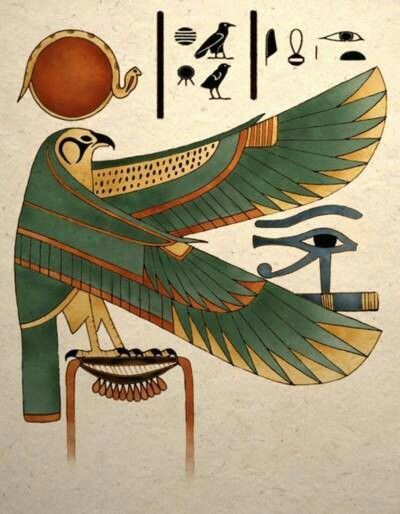
Ra shared many of his symbols with other solar deities, in particular Horus, usually depicted as a falcon. After the deities were paired with pharaohs, the children of Hathor were considered to be fathered by Ra.
- The Tree of Life
The Tree of Life is an important religious symbol to the Egyptians. The Tree of Life was located within Ra’s sun temple in Heliopolis and was considered sacred. The fruit that sprang from this tree was not available to humans, but only in aging-rituals reserved for pharaohs. The Tree of Life is also referred to as the mythical, sacred Ished tree. Eternal life came to those who ate the fruit from the Tree of Life.
- Bennu Bird or Phoenix
Another important ancient Egyptian symbol connected to Ra is the “Bennu.” The Bennu bird is Ra’s ba and a symbol of fire and rebirth. Bennu is the name of the bird that represented Ra’s soul.
This bird is a phoenix and it was seated at the Tree of Life in Ra’s Sun Temple in Heliopolis. Inside the temple, on top of an obelisk, sat the Benben Stone. This pyramid-shaped stone served as a beacon to Bennu and is also an important ancient Egyptian religious symbol. Sometimes, Ra is depicted as a phoenix, showing the connection between the two.
- Primordial Serpent and Sun Boat
Ra was thought to travel in a sun boat to protect its fires from the primordial waters of the underworld it passed through during the night.
The ancient Egyptians believed that as the sun god, Ra’s role was to sail across the heavens during the day in his boat called the “Barque of Millions of Years.” In the morning when Ra emerged from the east, his boat was named, “Madjet” which meant “becoming strong.” By the end of the day the boat was called, “Semektet” which meant “becoming weak.” At the end of the day, it was believed that Ra died (swallowed by Nut) and sailed on to the underworld, leaving the moon in his place to light up the world.
The ancient texts describe how Ra would go down with the setting sun into the underworld and then rise again the next day on the opposite side. This also symbolizes the same journey that the deceased would take right after burial.
The journey was divided into 12 hours, with each hour representing an obstacle that Ra had to complete in order to move onto the next. Each area has gods and monsters that Ra meets along the way.
Throughout his journeys and adventures, the serpent-god Apep is his greatest enemy. Apep would hide below the horizon waiting to attack Ra, and they would fight many battles. Many gods and goddesses were involved in defending Ra, including the god Seth.
Ra was reborn at dawn the very next day. Ra traveled in the sun boat with various other deities including Set and Mehen who defended against the monsters of the underworld, and Ma’at who guided the boat’s course. The monsters included Apep, an enormous serpent, or also, The Lord of Chaos, who tried to stop the sun boat’s journey every night by consuming it. In some stories, Ra, in the form of a cat named Mau, defeats the evil serpent, Apep. This is part of the reason why cats are so highly-revered in Egypt.
The Ra myth saw the sunrise as the rebirth of the sun by the goddess Nut and the sky, thus attributing the concept of rebirth and renewal to Ra and strengthening his role as a creator god.
In the Pyramid Text, Re is perpetually resurrected in the mornings in the form of a scarab beetle, Khepri, which means the Emerging One. He rides on the primordial waters, called Nun, in his sacred bark (boat) along with a number of other deities across the sky. At noon he is the falcon-headed man Harakhty, and at sunset the elder Atum, the “All Lord.” He is then swallowed by the goddess Nut, who gives birth to him each morning again as Khepri.
Therefore, the cycle continued with birth, life and death. This constant aging was suggested by some later Egyptians as the reason Ra stayed separate from the world and let Osiris or Horus rule in his place.
Often coupled with this idea is the myth in which Isis is able to trick an elderly Ra, having ruled on earth as a human pharaoh, into revealing his secret name, and thus the secret of his power. Ra subsequently lost his power, resulting in the cult of Isis and Osiris to rise in importance.
- Other Symbols
The Obelisk represents the rays of the sun and was worshiped as a home of a solar god. Other symbols include Pyramids aligned east to west, the Bull, Serpent, Heron, Lion, Cat, Ram, Hawk, Beetle, and others. His main symbol, however, is the sun disk.
Ra’s Appearance
Ra is usually shown in his human form with a falcon head crowned with a sun disc. The famous sun disc was surrounded by a sacred cobra named Uraeus. In some artistic representations of the god, he is shown as “a man with the head of a beetle” or sometimes as “a man with the head of a ram”.
Sometimes Ra is shown in animal form; most commonly, Ra is shown as a hawk, but sometimes also a beetle, lion, ram, or snake, as all of these were considered powerful animals in ancient Egypt. In iconography, Egyptians sometimes painted Ra as simply a large solar disk between two large falcon wings. Ra was incorporated into many aspects of Egyptian art, and he can be seen in paintings, sculptures, statues, and even jewelry.
Composites
As with most widely worshiped Egyptian deities, Ra’s identity was often confused with others as different regional religions were merged in an attempt to unite the country.
- Amun Re
Amun was a member of the Ogdoad, representing creation energies with Amaunet, a very early patron of Thebes. He was believed to create via breath, and thus was identified with the wind rather than the sun. As the cults of Amun and Ra became increasingly popular in Upper and Lower Egypt respectively they were combined to create Amun-Ra, a solar creator god. The name Amun-Ra is reconstructed).
It is hard to distinguish exactly when this combination happened, but references to Amun-Ra appeared in pyramid texts as early as the fifth dynasty. The most common belief is that Amun-Ra was invented as a new state deity by the (Theban) rulers of the New Kingdom to unite worshipers of Amun with the older cult of Ra around the eighteenth dynasty.
- Atum-Ra
Atum-Ra (or Ra-Atum) was another composite deity formed from two completely separate deities, however Ra shared more similarities with Atum than with Amun. Atum was more closely linked with the sun, and was also a creator god of the Ennead. Both Ra and Atum were regarded as the father of the deities and pharaohs, and were widely worshiped. In older myths, Atum was the creator of Tefnut and Shu, and he was born from ocean Nun.
- Ra-Horakhty
In later Egyptian mythology, Ra-Horakhty was more of a title or manifestation than a composite deity. It translates as “Ra (who is) Horus of the Horizons”. It was intended to link Horakhty (as a sunrise-oriented aspect of Horus) to Ra. It has been suggested that Ra-Horakhty simply refers to the sun’s journey from horizon to horizon as Ra, or that it means to show Ra as a symbolic deity of hope and rebirth.
- Khepri and Khnum
Khepri was a scarab beetle who rolled up the sun in the mornings, and was sometimes seen as the morning manifestation of Ra. Similarly, the ram-headed god Khnum was also seen as the evening manifestation of Ra. The idea of different deities (or different aspects of Ra) ruling over different times of the day was fairly common, but variable.
With Khepri and Khnum taking precedence over sunrise and sunset, Ra often was the representation of midday when the sun reached its peak at noon. Sometimes different aspects of Horus were used instead of Ra’s aspects. In Thelema’s Liber Resh vel Helios, Ra represents the rising sun, with Hathor as the midday sun and Tum as the setting sun.
- Ptah
Ra rarely was combined with Ptah; the sun “crosses” over Ptah in the underworld before Ptah is reborn, thus there would be no sun-ray when this happens. Other combinations can and do exist: The rising sun with sun ray, the noon sun with sun ray, and sitting sun with sunray. But as per the Memphite creation myth he was often said to be Ptah’s first creation, through his divine will, especially when associated with Atum or Amun.
The Legend of Ra Isis and The Snake
Although Ra was highly revered and devoutly worshiped by the ancient Egyptians, there is a story to suggest he eventually grew weak. In the Legend of Ra, Isis and the Snake, the goddess Isis knew that Ra had a secret name. This secret name possessed immense power and would allow her to perform magic spells whenever she desired to.
She knew that Ra wouldn’t willingly tell her the name so she quickly got to work. Ra had begun to age and sometimes saliva dribbled from his mouth. Isis visited with him one day. She collected the spit that dribbled down his chin and mixed it with dirt and clay. She shaped her mixture into a poisonous snake.
She set the snake in Ra’s path, and when Ra was out for a walk, the snake bit him and he immediately felt the poison rushing through his body. He was in tremendous pain and asked the other gods to help him. Isis promised to help Ra but only if he would tell her his secret name. He was resistant at first, but eventually, because of the pain he was in, Ra allowed Isis to “search through him” and in so doing, she healed him and Ra’s power was transferred over to her.
The Birth of Humans
One myth tells us that Ra first came to power during the golden age. Everything was perfect and just as it should be. The earth had not been tainted in any way. The sight of such perfection moved Ra to tears and they fell to the earth. The tears grew into humans.
At first, Ra was infatuated with watching humans interact and grow. But then he became angered with them as they ended the golden age that he had loved so much. They were cruel to each other and were ruining the earth.
He summoned the goddess Hathor and transformed her into a savage lioness. He then sent her to earth to kill every human. Hathor attacked every human she came across, killing most. But before she could eliminate all humans, Ra had a change of heart. He decided he needed to stop Hathor and did so by giving her enough beer to intoxicate her. She forgot her mission but the damage she had caused was permanent. Humans had been introduced to death and now all faced their immortality.
Quick Facts About Ra
- The ancient Egyptians worshiped Ra to such an extent above other gods that some historians have argued that ancient Egyptian religion was indeed a monotheistic one with Ra as the singular god.
- Historians believe that the pyramids might represent rays of sunlight, further connecting the pharaohs with Ra, the sun god.
- During Ra’s journey through the heavens he was accompanied by several other gods including Thoth, Horus, Hathor, Maat, Abtu, and Anet.
- Nut, goddess of the sky and heavens, is sometimes referred to as Ra’s mother, because he emerges from her and is reborn every morning.
- The morning manifestation of Ra is known as “Khepri the scarab God.”
- The evening manifestation of Ra is known as the ram-headed god, Khnum.
- The sacred cobra that encircled Ra’s crown symbolized royalty, sovereignty and divine authority.
- The right eye of Ra represented the Sun; while the left eye of Ra represented the moon.
- Ra is also closely associated with the Tree of Life myth, the Ben-Ben Stone and the Bennu Bird myths.
- Ra’s glory came to an end during the time when the Roman’s conquered Egypt in 30BC.
The Creation of Ra
Ra did not have parents. He is considered to be self-created and there are many myths that suggest how this came to be. It is said that before there was any land or recognizable landscapes, there was a body of water called Nun. The water was powerful and a shining egg arose from the darkness. Inside this egg was Ra. Sun rays landed on his body and gave him the power of sunlight. He then created all other elements of life by speaking their secret names. He spent his days traveling across the sky on a boat, where he carried prayers and blessings for the living.
At night, he would travel to the Underworld where Set and Mehen would help him defeat demons and monsters. He would leave the moon in the sky while traveling to the Underworld so that the living would still have light. It is said that he was reborn each day as the sun would rise over the horizon.
The Family of Ra
Ra had several siblings, including Apep, Thoth, Sobek and Serket.
Early in his myths Ra was said to be married to Hathor and they were the parents of Horus. Later his myths changed Hathor into Ra’s daughter. This featured prominently in the myth often called The Story of Sekhmet, in which Ra sent Hathor down to punish humanity as Sekhmet.
The Middle Kingdom saw Ra being increasingly combined and affiliated with other deities, especially Amun and Osiris.
Together with Atum, Ra was believed to have fathered Shu and Tefnut who in turn bore Geb and Nut. These in turn were the parents of Osiris, Isis, Set (also known as Seth), and Nephthys. All nine made up the Heliopolitan Ennead.
Worship of the Sun God
The New Kingdom brought new heights of worship to Ra. Many tombs in the Valley of the Kings portray depictions of Ra and his journey through the underworld. During this time, many solar temples were built.
Solar temples were built for Ra but did not contain a statue of the god. Instead, they were created to be open to the sunlight that Ra represented. The earliest known temple built in honor of Ra exists in Heliopolis meaning “City of the Sun” (now a Cairo suburb). This solar temple is known as “Benu-Phoenix” and is believed to have been erected in the exact spot where Ra emerged into creation.
In later Egyptian dynastic times, Ra was merged with the god Horus, as Re-Horakhty (and many variant spellings). When his worship reached this position of importance in the Egyptian pantheon, he was believed to command the sky, the earth, and the underworld.
His local cult began to grow from roughly the second dynasty, establishing Ra as a sun deity. By the fourth dynasty the pharaohs were seen to be Ra’s manifestations on earth. Fifth Dynasty and subsequent pharaohs were all known as “The son of Ra” and Ra became incorporated into every pharaoh’s name from then onward. His worship increased massively in the fifth dynasty, when he became a state deity and pharaohs had specially aligned pyramids, obelisks, and solar temples built in his honor.
During the Middle Kingdom, the new deity, Amun-Ra was formed. Amun was one of the gods who formed the Ogdoad (the assembly of eight gods who represented eight elements of creation).
It appears almost certain, that the Great Ennead – the nine deities of Atum, Geb, Isis, Nut, Osiris, Nephthys, Seth, Shu, and Tefnut – first appeared during the decline of Ra’s cult in the sixth dynasty, and that after introduction of the new pesedjet the cult of Ra soon saw a great resurgence until the worship of Horus gained prominence.
As the king and leader of Egypt, the pharaoh was seen as the human manifestation of Horus, so the two gods became connected. This new deity fusion was then referred to as “Ra-Horakhty” meaning Ra is Horus of the Horizon. Ra’s relationship with other gods did not stop there. As the powerful creator of mankind and the sun god, he also became associated with Atum to make “Atum-Ra.”
Afterward worship focused on the syncretistic solar deity Ra-harakhty (Ra, who is Horus of the Two Horizons). During the Amarna Period of the eighteenth dynasty, Akhenaten introduced worship of another solar deity Aten. The deified solar disc represented his preferred regional deity as he attempted to lessen the influence of the temple of Atum. He built the Wetjes Aten (Elevating the Sun-disca) temple in Annu. Blocks from this temple later were used to build walls to the medieval city of Cairo and are included in some of the city gates. The cult of the Mnevis bull, an embodiment of Ra, had its centre here and established a formal burial ground for the sacrificed bulls north of the city.
In the later myths Ra was seen to have created Sekhmet, the early lioness war goddess who becomes Hathor, the cow goddess after she has sufficiently punished mankind as an avenging Eye of Ra.
This changes the themes of much earlier myths into aspects of his and he is often said to be the father of both, and brother, to the god Osiris. Afterward nearly all forms of life supposedly were created only by Ra, who called each of them into existence by speaking their secret names and eventually humans were created from Ra’s tears and sweat, hence the Egyptians call themselves the “Cattle of Ra.”
Although not the contemporary view, E. A. Wallis Budge (1857-1934) claims that Ra was the one god of Egyptian monotheism, of which all other deities were aspects, manifestations, phases, or forms.
During the New Kingdom, the worship of Ra became more complicated and grand. The walls of tombs were dedicated to extremely detailed texts that told of Ra’s journey through the underworld. Ra was said to carry the prayers and blessings of the living with the souls of the dead on the sun boat.
The idea that Ra aged with the sun became more popular with the rise of The New Kingdom. Eventually, during the reign of Akhenaten (mid 1350s-1330s), the worship reached the level of “uncompromising monotheism”
Many acts of worship included hymns, prayers, and spells to help Ra and the sun boat overcome Apep. Though worship of Ra was widespread, his cult center was in Heliopolis in Lower Egypt. Oddly enough, this was the home of the Ennead that was believed to be headed by Atum, with whom he was merged. The Holiday of ‘The Receiving of Ra’ was celebrated on May 26 in the Gregorian calendar.
Though Ra lived on in various forms into the Greco-Roman period, his worship gradually deteriorated during the fist millennium. This decline was probably due to the weakening of the kingship under various foreign rulers. Though he continued to be a part of Egyptian theology, he was no longer a part of the peoples living faith. Devotion to Ra became more and more limited to priests of the temple.
The rise of Christianity in the Roman empire caused an end to worship of Ra by the citizens of Egypt, and as Ra’s the popularity suddenly died out, the study of Ra became purely for academic knowledge even among the Egyptian priests.
Sources:
- Title: The Good Spirit
- Other Names: Agathodemon, Agatho Daimon
- Origin: Egypt
- Preferred offering: Wine
- Manifestations: Consistently serpentine, he may appear as an ordinary snake or a hovering winged serpent.
Agathodaemon is a benevolent spirit of healing, protection, luck, and good fortune who manifests as a snake. Veneration of Agathodaemon traveled from Egypt to Greece and Italy. He is a consistently benevolent spirit. In Egypt, he evolved into a Gnostic guardian angel.
Agathodaemon is a companionable spirit. Among the deities with whom he happily shares altar space are Serapis, Tyche, and Hermes. He may be fond of Sicily’s Saint Agatha who may or may not be an ancient serpent-goddess in disguise.
Agathodaemon survives in modern Egypt, too, albeit undercover. Each of Cairo’s four quarters allegedly possesses its own snake-shaped guardian spirit, its own Agathodaemon.
The Greek version of this deity, is known by Agathos, or Agatho Daemon. Information on this version of the Serpent Spirit can be found here: Agathos.
Source: Encyclopedia of Spirits
- Names: Nit
- Attributes: Two arrows and a shield, shuttle
- Creatures: Crocodile, snake, bee
- Color: Green
- Plants: Flax, papyrus
- Favored people: Soldiers, hunters, weavers, artisans
The inscription on Neith’s temple in Sais in the Nile Delta (now modern Sa el-Hagar) read:
I am all that has been,
that is and that will be
No mortal has yet been able
to lift the veil that covers me.
Neith, the First One, the primordial goddess, was never born but always existed. Alternatively she is completely self-generated. Neith traveled from the deserts and oases of Libya to emerge as among the greatest of Egyptian goddesses. In one Egyptian creation myth, Neith brought forth Ra, the sun. Then she invented the shuttle and loom, put the sky on her loom, and wove the world into existence. Neith, the first to give birth, invented weaving. Her name may derive from a word for “to weave” or “to knit.”
She is called:
- The Oldest One
- Nurse of Crocodiles
- The Huntress
- Opener of the Ways
- Great Goddess
- Lady of the West
Mother of the Gods, goddess of war and the hunt, she is goddess of the lower heavens, a warrior goddess and protectress. Her name means “I have come from myself,” or self-begotten.
Eternal goddess, universal mother; the Spirit behind the Veil of Mysteries; World Body; Primal Abyss. Her cult was a very ancient one with two queens of the First Dynasty named after her. Often shown along side Selqet as mummy guardian and protectress of marriage. She wore the red crown of Lower Egypt. In her hands she held a bow and two arrows.
Neith is a goddess of hunting. She presides over crafts of all kinds, including witchcraft and warcraft. Amuletic weapons placed in the tomb to protect the deceased from evil spirits were consecrated to Neith. She is the judge of the Egyptian deities. After eighty years, when the lawsuit between Horus and Set in the Court of Deities was still not resolved, Neith was called in to render a decision to which all could defer. (She favored Horus but compensated Set. Neith has historically had a close positive relationship with Set.)
Her ceremonies were of a mystic nature. Neith was worshiped with Mysteries and lantern processions. In December (on or around December 8th), a great festival, called the Feast of Lamps, was held annually in her honor and, according to Herodotus, her devotees burned a multitude of lights in the open air all night during the celebration.
She is the patroness of domestic arts, weaving, hunting, medicine, war, and weapons. Turn to her when working with herbs, magick, healing, mystical knowledge, rituals, and meditation. She is the protectress of women and marriage.
She may be venerated independently or together with her son, Sobek. The Greeks identified her with Athena, also identified as originating in Libya. Many consider Athena to be a Greek path of Neith or at least a very closely related spirit.
Neith appears as an androgynous woman. She wears the red crown of Lower Egypt. She sometimes appears in the guise of a golden cobra, as well. In Iconography, she is customarily depicted with a green face and hands. Neith is portrayed suckling a crocodile at each breast.
The main imagery of Neith was as the deity of the unseen and limitless sky, as opposed to Nut and Hathor, who respectively represented the manifested night and day skies. Her epithet as the “Opener of the Sun’s Paths in all her stations” refers to how the sun is reborn (due to seasonal changes) at various points in the sky, under her control of all beyond the visible world, of which only a glimpse is revealed prior to dawn and after sunset.
It is at these changing points that Neith reigns as a form of sky goddess, where the sun rises and sets daily, or at its ‘first appearance’ to the sky above and below. It is at these points, beyond the sky that is seen, that her true power as the deity who creates life is manifested.
This ancient goddess represents the full ecliptic circle around the sky (above and below). It was this realm, the cosmos below the horizon, that Neith personified, for she is the complete sky which surrounds the upper and lower sky, and which exists beyond the horizon, and thereby beyond the skies themselves. Neith, then, is that portion of the cosmos which is not seen, and in which the sun is reborn daily, below the horizon which may reflect the statement assigned to Neith as “I come at dawn and at sunset daily.”
As the goddess of creation and weaving, she was said to reweave the world on her loom daily. An interior wall of the temple at Esna records an account of creation in which Neith brings forth from the primeval waters of the Nun the first land. All that she conceived in her heart comes into being, including the thirty deities. Having no known husband she has been described as “Virgin Mother Goddess.”
Unique Goddess, mysterious and great who came to be in the beginning and caused everything to come to be . . . the divine mother of Ra, who shines on the horizon…
Sources:
The deities listed here are by no means all those recorded in the Egyptian pantheon. It would be impossible to list them all. Anyone interested in an in-depth study of Egyptian deities should read The Gods of the Egyptians by E. A. Wallis Budge. Also there are vast differences in the spellings of Egyptian deity names. This is because Egyptian hieroglyphs had no vowels.
This is a simple list of Egyptian gods and goddesses from Egyptian mythology, along with their titles and some of their attributes. The ancient Egyptians worshiped many gods at different times and in different places. Some gods changed in importance over time.
A
Aebehout (Kebehet, Kabachet, Kebhut, Kebechet, Qebhut, Qeb-Hwt) – Goddess of the Water of Life. The goddess of purification, also is known as the wandering goddess or the lost child, she presides over the magical reviving power of water.
Amaunet (Amunet) – Goddess of Heaven, Wife of Amun. (see also Amonet)
Amen (Amoun, Amun, Amon, Ammon) – The Hidden One; Lord of the Libyans; Lord of the Setting Sun and Moon; The Time Lord; Earth Father; Giver of Breath; Giver of Life, Vizier of the Humble, Who Answers the Voice of the Poor. The great god of Thebes of uncertain origin; represented as a man, sometimes ithyphallic; identified with Re as Amen-Re; sacred animals, the ram and the goose.
Ament (Amenti) – The Westerner; The Hidden Goddess; Goddess of the Land of the West; Goddess with Beautiful Hair. She welcomed all deceased people to the land of the dead with bread and water. (see also Amonet)
Ammit (Ammut, Ahemait) – The Eater, Devourer of the Dead; Eater of Hearts; Bone Eater; Devourer of Millions; Greatness of Death. This is the crocodile goddess also known as Ammit the Devourer. She also assists Anubis with carrying out the Judgements,
Amonet (Amunet, Amaunet, Ament, Imentet, Amentat) – The Mother Who Is Father. A primordial spirit composed of the two deities Ammon and Ammit.
Amun-Ra (Akmun-Ra, Ra, Re, Phra) – The Creator; The Supreme Power; The Only One; Great Father; Father of the Gods; Sun God. Ra is the god of the Sun, head of the great ennead, supreme judge; often linked with other gods aspiring to universality, and king of the gods until Osiris took over his throne.
Anat (Anath, Anta) – The Girl; Lady of Heaven; Mistress of All Spirit; Strength of Life; Lady of Mercy. A goddess of Syrian origin, with warlike character; represented as a woman holding a shield and an axe.
Anhur (Anher, Anhert, Onouris) – Skybearer, The Divine Huntsman. Very early aspect of Osiris, God of war, sun and the sky.
Anput – Goddess of the seventeenth Nome of Upper Egypt
Anubis (Anpu, Sekhem Em Pet) – Foremost of the Westerners. He is god of judgement of life and death, the jackal-god, patron of embalmers; the great necropolis-god.
Anuket (Anqet, Anukis, Anoukis) – The Clasper; The Embracer; Bestower of Life; Lady of Nubia. She is the goddess of river Nile and the cataract-region at Aswan; wife of Khnum; represented as a woman with a high feather head-dress.
Apep (Apophis) – The chaos snake. Demon enemy of the Sun, the eternal enemy of Ra. He is a god of chaos and war.
Apet (Opet, Tauret, Taurt, Thoueris, Rertrertu, Taweret, Ta-Urt, Tauret) – Mistress of Talismans. The hippopotamus goddess, a beneficent deity, the patron of woman in child-birth and goddess of fertility. In her darker aspect she was the goddess of darkness and revenge.
Arsaphes (Herishef)- A ram-headed god from Heracleopolis.
Apis – A live bull worshiped as a god at Memphis. This is a rare case of an animal being worshiped as a god while alive, then mummified when he died.
As (Aset, Eset, Tait, Isis) – Supreme Egyptian Goddess, Great Mother, Giver of Life.
Astarte (Ashtarte) – Lady of Heaven; Mother of the Blessed. A goddess of Syrian origin; introduced into Egypt during the Eighteenth Dynasty.
Atem (Atum /Temu, Tem) – Dark Eye of Ra. Personification of God in human form and of the setting Sun. Father of the human race, he helped the dead. In one of his forms he was worshiped as a huge serpent.
Aten – The disk of the sun Originally an aspect of Ra
Athor (Athyr, Hert, Hat-Hor, Hathor) – The Great One of Many Names; The Golden One; Lady of Malachite; Lady of Turquoise; Sady of the Sycamore; Lady of the Date Palm; Lady of the West; Lady of the Dead; The Womb of Horus; House of Horus; Lady of the Evening; My House in the Sky; Lady of the Uterus; Lady of the Vulva; The Womb Above. This popular goddess is the matron goddess of all women, the embodiment of the female principle. She has many functions and attributes.
Auser (Osiris)- Lord of the Far World. Osiris is the god of the underworld and the afterlife. He is identified as the dead or mummified king; also a god of the inundation and vegetation.- Lord of life after death, Sun god, Universal Lord
Au Set (Isis, As, Aset, Eset, Tait) – The Great Lady; Queen of the Earth; Light Giver of Heaven; Mistress of Magic; The Many Named; Queen of the Throne; She Who Is Rich in Spells; Great of Sorcery; Redemptress: Star of the Sea; The One Who Is All; Mother of Gods. Isis is the divine mother, goddess of magic, marriage, healing, and motherhood. She is the wife and sister of Osiris and the mother of Horus. She is one of the four ‘protector’-goddesses, guarding coffins and Canopic jars; sister of Nephthys with whom she acted as a divine mourner for the dead. Supreme Egyptian Goddess, Great Mother, Giver of Life
Auf (Euf Ra) – Aspect of the Sun god Ra
B
Babi – God of baboons
Ba-neb~Tetet (Banebedet, Banaded, Banabdedet, Banabdjedet) – The Soul of Mendes; Lord of Mendes; The Ram of Mendes. The calm cool headed ram deity who found a peaceful solution to the power struggle between Horus and Set. God of discussion, arbitration, peace.
Bast (Bastet, Pasht) – Mistress of the Oracle; Great Conjuress of the Casket. The cat goddess with dominion over sex, fertility, marriage, magic, music, childbirth, and the pleasures of life. Cat Goddess known to protect pregnant women and children. The protector of Ra, his third eye.
Bes – Dancing. Lord of the Land of Punt. Bes is the dwarf god with leonine features; a domestic god, protector against snakes and various terrors; helper of women in child-birth. Dwarf God God of Pregnant woman, newborn babies, and family also known to protect from snake and scorpion bites
Buto (Uajyt, Uatchet, Utchat, Per Uadijit, Uazrr, Uto, Uraeus) – Eye of Ra; Lady of Heaven; Lady of the North. At times she was portrayed as a cobra, sometimes winged, sometimes crowned. Goddess of protection, hiding from evil. See also Wadjet.
D
Djehuti (Zehuti. Thoth, Tehuti, Thout) – Lord of Divine Words; Lord of Books. Thoth is the ibis-headed scribe of the gods, the god of wisdom, inventor of writing. The ape as well as the ibis is sacred to him. Judge of the Gods.
E
Edjo (Buto, Wadjet, Udjat) – Goddess of protection. Sister of Nekhbet. Lady of Flame; Lady of the North; Lady of Heaven; Queen of Holy Spirits. The cobra-goddess of Buto in the Delta, a goddess of protection, appearing on the royal diadem, protecting the king.
Ernutet (Renenet, Renenutet) – Lady of the double granary, Goddess of the 8th month of the Egyptian calendar.
Eset (Tait, Isis, As, Aset) – Supreme Egyptian Goddess, Great Mother, Giver of Life.
Euf Ra (Auf) – Aspect of the Sun god Ra
G
Geb (Keb, Seb) – Father of the Gods. A fertility Earth god, similar to the Greek Cronus, always shown with erect phallus. Presides over fertility, new beginnings, creation, and crops.
H
Hapi – God of the Nile in inundation; represented as a very fat man. God of the Nile, crops, fertility, water, and prosperity.
Hat-Hehit – Fish-goddess of Mendes in the Delta; sometimes represented as a woman with a fish on her head.
Hathor (Athor, Athyr, Hert, Hat-Hor) – The Great One of Many Names; The Golden One; Lady of Malachite; Lady of Turquoise; Lady of the Sycamore; Lady of the Date Palm; Lady of the West; Lady of the Dead; The Womb of Horus; House of Horus; Lady of the Evening; My House in the Sky; Lady of the Uterus; Lady of the Vulva; The Womb Above. This popular goddess is the matron goddess of all women, the embodiment of the female principle. She has many functions and attributes.
Heh (Neheb) – God of eternity, longevity, and happiness. Shown as a man squatting on the ground wearing a curved reed on his head.
Heqet (Heqtit, Heket) – Midwife of the Sun, Giver of Life; Spirit of the Primordial Waters; Mother of the Spirits. She is the frog-goddess of Antinoopolis where she was associated with Khnum; a helper of women in child-birth.
Herishef (Arsaphes) – A ram-headed god from Heracleopolis.
Horus (Haroeris, Haru-Er, Harsiesis, Harpocrates) – The Enchanted One. Horus is the god of war, sky, and falcons. He is regarded as the son of Osiris and Isis, for the former of whom he became the avenger.- Falcon headed Sun and Sky God, Divine Child, reborn Sun
I
Imentet (Amentat, Amonet, Amunet, Amaunet, Ament) – The Mother Who Is Father. A primordial spirit composed of the two deities Ammon and Ammit.
Imhotep (I-Em-Hetep, Imouthes) – He Who Comes In Peace. The deified chief minister of Djoser and architect of the Step Pyramid; in the Late Period venerated as the god of learning and medicine; represented as a seated man holding an open papyrus; equated by the Greeks with Asklepios. God of knowledge, medicine, magick, compassion, drugs, herbs, sleep
Isis (As, Aset, Eset, Tait, Au Set) – The Great Lady; Queen of the Earth; Light Giver of Heaven; Mistress of Magic; The Many Named; Queen of the Throne; She Who Is Rich in Spells; Great of Sorcery; Redemptress: Star of the Sea; The One Who Is All; Mother of Gods. Isis is the divine mother, goddess of magic, marriage, healing, and motherhood. She is the wife and sister of Osiris and the mother of Horus. She is one of the four ‘protector’-goddesses, guarding coffins and Canopic jars; sister of Nephthys with whom she acted as a divine mourner for the dead. Supreme Egyptian Goddess, Great Mother, Giver of Life
K
Kabachet (Kebhut, Kebechet, Qebhut , Qeb-Hwt, Aebehout, Kebehet) – Goddess of the Water of Life.The goddess of purification, also is known as the wandering goddess or the lost child, she presides over the magical reviving power of water.
Keb (Seb, Geb)- A fertility Earth God of new beginnings, creation, crops.
Khepri – God of scarab beetles Ra’s aspect in the morning
Khensu (Khons, Khonsu) – God of the Moon; Traveler; The Navigator; He Who Crosses The Sky In A Boat; God of the New Moon. He is the moon-god, represented as a man; with Amun and Mut as father and mother, forming the Theban triad.
Khepera (Khepra, Khepri, Kebechet, Khepera, Kefri) – Father of the Spirits, He Who Becomes. The scarab-beetle god, identified with Re as a creator-god; often represented as a beetle within the sun-disk. A god of transformations, rebirth, resurrection of the body, reincarnation, and rebirth.
Khnemu (Khnum, Khnoum) – The Sculptor Who Gives Life; The Molder; The Divine Potter; Lord of Destiny; Father of Fathers; Mother of Mothers; Lord of the Cool Water. The ram-headed god of Elephantine, god of the Cataract-region; thought to have molded man on a potter’s wheel. Ra’s aspect in the evening.
Kuk – Personification of darkness
M
Maahes – Egyptian lion-headed god of war
Maat (Ma’at, Maa, Maut, Mayet) – Lady of Heaven; Queen of Earth; Mistress of the Underworld; Eye of Ra; Daughter of Ra; Lady of the Judgment Hall. Ma’at is the goddess of justice,order, truth, right, and orderly conduct; represented as a woman with an ostrich-feather on her head.
Mafdet – God of justice. Executioner of criminals, protector of the King’s chambers
Mehueret, Mehurt – Lady of Heaven; Mistress of the Earth. A universal Mother Goddess associated with night.
Menhit – Minor lion goddess, Wife of Anhur
Menthi (Menthu-Ra, Mentu, Mont) – Sun god, often with a bull head. In his war aspect he personified the destroying heat of the sun. God of protection, war, and vengeance.
Meretseger – She Who Loves Silence; Lioness of the Summit; Lady of the Necropolis. A protector of tombs and guardian of the Necropolis.
Meshkenet (Meskhenet) – Goddess of Childbirth. Protects laboring women and newborn babies.
Min (Minu, Menu) – Lord of the Eastern Desert; Lord of Foreign Lands. The primeval god of Coptos; later revered as a god of fertility, and closely associated with Amun.
Mut – Lady of Heaven; Queen of Deities; Mother of the Mothers. The vulture-goddess who is the spirit of maternity. Her name means “mom.” An extremely beloved goddess later represented usually as a woman.
N
Neheb (Heh) – God of eternity, longevity, happiness
Nehebkau – Serpent God of the Underworld
Nefertem (Nefert-Temu, Nefertu) – The Lord of Fragrance. He is the god of the lotus, and hence of unguents, perfumes and fragrance; worshiped at Memphis as the son of Ptah and Sakhmet; represented as a man with a lotus-flower head-dress.
Nehebkau (Neheb-kau) – A serpent god of the Underworld, dangerous to both the gods and humans. Death, cursing, vengeance. Some-times represented with a man’s body and holding the eye of Horus.
Neith (Neit, Net, Nit) – The Oldest One; Nurse of the Crocodiles. This goddess of Sais is represented as a woman wearing the red crown; her emblem, a shield with crossed arrows; one of the four ‘protector’-goddesses who guarded coffins and Canopic jars; identified by the Greeks with Athena.
Nekhbet (Nekhebet) – Lady of the South. The vulture-goddess of Upper Egypt, presides over maternity, childbirth, life and death.
Nephthys (Nebt-Het, Nebthet, Nebhet) – Funerary Goddess, Lady of the House; Lady of Life; Lady of Darkness; Lady of Death that Is Not Eternal; Mistress of the Palace, The Revealer, Mistress of the West. Nephthys is the river goddess, sister of Isis; one of the four ‘protector’-goddesses, who guarded coffins and Canopic jars; with Isis acted as mourner for Osiris and hence for other dead people.
Nun (Nu) – God of the primeval chaos.
Nut (Nu) – Life giver, Mother of the Gods, Protector of the Dead. Mother of Stars; Queen of Heaven; Mother of the Deceased; She Who Holds a Thousand Souls; Mistress of All; She; Who Protects. Nut is the goddess of sky and stars, represented as a woman, her naked body curved to form the arch of heaven.
O
Onnophris (Unnefer, Wenen-Nefer) – a name meaning ‘he who is continually happy’, given to Osiris after his resurrection.
Onouris (Anhur, Anher, Anhert) – Skybearer, very early aspect of the God Osiris
Opet (Tauret, Taurt, Thoueris, Rertrertu, Taweret, Ta-Urt, Tauret, Apet) – Mistress of Talismans. The hippopotamus goddess, a beneficent deity, the patron of woman in child-birth and goddess of fertility. In her darker aspect she was the goddess of darkness and revenge.
Ophis (Wepwawet, Upuaut) – Opener of the Ways. the jackal-god of Asyut in Middle Egypt; a god of the necropolis and an avenger of Osiris. Opener of roads, God of the Underworld
Osiris (Auser) – Lord of the Far World. Osiris is the god of the underworld and the afterlife. He is identified as the dead or mummified king; also a god of the inundation and vegetation.- Lord of life after death, Sun god, Universal Lord
P
Pakhet – A goddess of motherhood and of war
Pasht (Bast, Bastet) – Cat Goddess known to protect pregnant women and children. The protector of Ra, his third eye.
Per Uadijit (Uazrr, Uto, Uraeus / Buto / Uajyt, Uatchet, Utchat) – Cobra goddess and protectress of Lower Egypt
Ptah (Ptah-Neb-Ankh) – The Opener, the Divine Artificer, Father of Beginnings, Creator God. Lord of the Sky; Lord of the Two Lands; Lord of Truths; Lord of Sunrise; Father of Fathers; Power of Powers. He is the god of creation, creator-god of Memphis, the patron god of craftsmen; equated by the Greeks with Hephaestus.
Ptah-Seker-Osiris – A composite deity, incorporating the principal gods of creation, death, and after-life; represented like Osiris as a mummified king.
Phra (Ra, Re) – The Supreme Power, The Creator, Great Father
Q
Qebhut (Qeb-Hwt, Aebehout, Kebehet, Kabachet, Kebhut, Kebechet) – Goddess of the Water of Life. The goddess of purification, also is known as the wandering goddess or the lost child, she presides over the magical reviving power of water.
Qebui – God of the North Wind
Qetesh – A mother-goddess of fertility. Adopted into ancient Egypt from Kadesh in what is now Syria.
R
Ra (Re, Phra, Amun-Ra, Akmun-Ra) – The Creator; The Supreme Power; The Only One; Great Father; Father of the Gods; Sun God. Ra is the god of the Sun, head of the great ennead, supreme judge; often linked with other gods aspiring to universality, and king of the gods until Osiris took over his throne.
Raet-Tawy – Female sun goddess of Upper and Lower Egypt. Female counterpart of Ra.
Rat (Tat-Taiut, Rait) – Lady of the Heavens; Mistress of the Gods; Mistress of the Heliopolis; Mother of the Gods; Goddess of the Two Lands. Goddess of wisdom and knowledge, shown as a woman wearing a disk with horns and a uraeus.
Renenet (Renenutet, Ernutet, Thermuthis) – She Who Rears; The Nourishing Snake; Lady of the Double Granary .Goddess of harvest and fertility; represented as a snake or a snake-headed woman. Goddess of the 8th month of the Egyptian calendar.
Renpet – Mistress of Eternity. Goddess of youth, springtime, the year, and the general idea of time.
Rertrertu (Taweret, Ta-Urt, Tauret, Apet, Opet, Tauret, Taurt, Thoueris) – Mistress of Talismans. The hippopotamus goddess, a beneficent deity, the patron of woman in child-birth and goddess of fertility. In her darker aspect she was the goddess of darkness and revenge.
Reshef (Reshpu) – God of war and thunder, of Syrian origin.
S
Sarapis – A god introduced into Egypt in the Ptolemaic Period having the characteristics of Egyptian (Osiris) and Greek (Zeus) gods; represented as a bearded man wearing the modius head-dress.
Sati (Satet, Satis) – She Who Shoots Forth; She Who Runs Like an Arrow; She Who Pours. This Nile River spirit is entrusted to maintain balance and peace at the Nile’s first cataract, the traditional border between Egypt and Nubia. Goddess of the Cataracts, Goddess of fertility, water, the hunt, planting.
Seb (Geb, Keb) – A fertility Earth God of new beginnings, creation, crops.
Sebek (Sobk, Suchos) – Lord of Death, the Hidden One.
Seker (Sokar, Socharis) – The guardian god of the door to the Underworld.
Sekhem Em Pet (Anubis, Anpu) – God of dead, embalming, funerals, and mourning ceremonies
Sekhmet (Sakhmet) – The Mighty One; The Terrible One; The Powerful; The Beloved of Ptah; Dark Sister of Bast; Great of Magic; Lady of Terror; Lady of Action; The One Before Whom Evil Flees; Mistress Dread; Lady of Flame; The Scarlet Woman. Goddess of lions and fire also goddess of vengeance, a lion-headed goddess worshiped in the area of Memphis; a fiery manifestation of the Eye of Ra. She represented the destroying power of sunlight and was the goddess of war and battle, physicians and bone-setters.
Selqet (Selket, Selquet, Selchis, Serqet, Serquet) – Mistress of the Beautiful House. A scorpion-goddess, identified with the scorching heat of the sun; one of the four ‘protector’-goddesses, guarding coffins and Canopic jars. Protectress of marriage, goddess of happy marriages and married sexual love.
Seshat (Seshet, Sesheta) – Lady of the Builder’s Measure; The Great One; Lady of the House of Books, Queen of Construction; Goddess of Writing. The goddess of writing and measurement, the divine keeper of royal annals.
Set (Seth, Seti, Sutekh, Suti, Sertesh) – Great of Strength; He Who Is Below; Lord of the Desert; Lord of Chaos and Disorder. God of deserts, storms and violence, evil, and chaos also later version ruler of the underworld. He is brother of Osiris and his murderer; the rival of Horus; equated by the Greeks with Typhon.
Shai (male), Shait (female) – Guardian angel, presiding over destiny and fate. Sometimes a Goddess, sometimes a God.
Shu – Lord of the Sky. God of Air and the North Wind. Connected with the heat and dryness of sunlight. Shu and Tefnut – his twin sister- form the first pair of gods in the Heliopolitan ennead; shown often as a man separating Nut (sky) from Geb (earth).
Sobek (Suchos, Sebek, Sobk) – Lord of Dark Water; The Hidden One; He Who is Shut In. Sobek is the crocodile-god, worshiped throughout Egypt. An aggressive guardian who repels and devours malevolent spirits who threaten his devotees. Rows Ra’s Sunboat through the Duat.
Sopdu – A god of war Associated with the sun and with the planet Venus
T
Tait (Isis, As, Aset, Eset) – Supreme Egyptian Goddess, Great Mother, Giver of Life.
Tatjenen – The primeval earth-god of Memphis; later identified with Ptah.
Tat-Taiut (Rait, Rat) – Lady of the Heavens, Goddess of Wisdom and knowledge.
Taweret (Thoeris, Taurt, Ta-Urt, Apet, Opet, Rertrertu) – Mistress of Talismans. The hippopotamus goddess, a beneficent deity, the patron of woman in child-birth and goddess of fertility. In her darker aspect she was the goddess of darkness and revenge.
Tefnut (Tefenet) – The goddess of moisture, dew, rain, and mist. She is said to live at the bottom of the underworld. She and her twin brother – Shu – form the first pair of gods in the Heliopolitan ennead.
Temu (Tem, Atem, Atum) – Dark Eye of Ra. Personification of God in human form and of the setting Sun. Father of the human race, he helped the dead. In one of his forms he was worshiped as a huge serpent.
Thoth (Tehuti, Thout, Djehuti, Zehuti) – Lord of Divine Words; Lord of Books. Thoth is the ibis-headed scribe of the gods, the god of wisdom, inventor of writing.The ape as well as the ibis is sacred to him. Judge of the Gods.
Thermuthis (Renenet, Renenutet, Ernutet) – She Who Rears; The Nourishing Snake; Lady of the Double Granary. Goddess of harvest and fertility; represented as a snake or a snake-headed woman. Goddess of the 8th month of the Egyptian calendar.
U
Uajyt (Uatchet, Utchat, Uazrr, Uto, Uraeus, Buto, Per Uadijit) – Cobra goddess and protectress of Lower Egypt
Udjat (Edjo, Buto, Wadjet) – Goddess of protection. Sister of Nekhbet. Lady of Flame; Lady of the North; Lady of Heaven; Queen of Holy Spirits. The cobra-goddess of Buto in the Delta, a goddess of protection, appearing on the royal diadem, protecting the king.
Unnefer (Wenen-Nefer, Onnophris) – a name meaning ‘he who is continually happy’, given to Osiris after his resurrection.
Upuaut (Ophis, Wepwawet) – Opener of the Ways. the jackal-god of Asyut in Middle Egypt; a god of the necropolis and an avenger of Osiris. Opener of Roads, God of the Underworld
W
Wadjet (Udjat, Edjo, Buto) – Goddess of protection. Sister of Nekhbet. Lady of Flame; Lady of the North; Lady of Heaven; Queen of Holy Spirits. The cobra-goddess of Buto in the Delta, a goddess of protection, appearing on the royal diadem, protecting the king.
Wadj-wer – Personifies the Mediterranean Sea and other lakes.
Wenen-Nefer (Onnophris, Unnefer) – A name meaning ‘he who is continually happy’, given to Osiris after his resurrection.
Wepwawet (Upuaut, Ophis) – Opener of the Ways. The jackal-god of Asyut in Middle Egypt; a god of the necropolis and an avenger of Osiris. Opener of Roads, God of the Underworld
Z
Zehuti (Thoth, Tehuti, Thout, Djehuti) – Lord of Divine Words; Lord of Books. Thoth is the ibis-headed scribe of the gods, the god of wisdom, inventor of writing.The ape as well as the ibis is sacred to him. Judge of the Gods.
Egyptian deities did not require human sacrifice or annihilation of people with their religious beliefs. Temples were not considered a place of communal worship. They were looked upon as houses for the deities; there, statues were kept and attended by priests and priestesses. The priesthood was not celibate. The pharaoh was considered an incarnated god upon Earth.
The life of the average Egyptian was a blend of religion and the use of magick. Magick was a vital part of every day life. The people believed that worship was basically a private, personal concern and duty. After all, the ancient Egyptians said, when you stood in the Hall of Judgment after death, no one could tamper with the scales that weighed your heart for truth and goodness. Your soul was laid bare; everything was revealed.
Individual worship was performed at home altars and certain shrines, with the populace as a whole participating in in the great seasonal festivals. The common people were not admitted to the great temples, but they made pilgrimages to certain shrines.
Since worship was considered a private concern, the ordinary person visited the temple of his choice for healing or to present petitions when he needed something. Even then, he entered only the outer courts of the temples. The inner sanctuary of the deity was entered only by the highest priests, priestesses, or the pharaoh.
Originally, the priests and priestesses did not believe in polytheism or animal worship. They believed that the god-forms each represented a principle or aspect of the Supreme Creator. They believed that as long as the spiritual needs of humans were met, it did not matter how the Ultimate Spirit was pictured. These priests / priestesses used a sacred language known only to them for all rituals and worship, probably the remnant of a very ancient language.
Some temples were centers of healing, “sleep houses,” where dream therapy and hypnosis were used to cure the sick. In these places, quiet music of special sounds and rhythms were employed for healing the whole person – body, emotions, mind, and spirit.
Egyptian worship was intertwined with music and dancing. The Singers could be either male or female, depending upon the deity they served. The Temple Dancers were most often female, spending their early years actively participating in the sacred dances, and their later years instructing the new Dancers.
Dancing and chanting made it necessary to have musicians. These were attached to the temples, as were the Dancers and Singers, and were usually female. Sometimes there were dramatic performances for very special religious rites.
The ancient Egyptians were well aware that humans had more than just a physical body. They said that humankind had seven souls. Much of the esoteric meaning of these forms has been lost. What we now know of these “souls” is limited.
Here is a simplified explanation of the seven souls:
- Khat – the physical body
- Ka – the body – soul. It came into existence when the body was born, lived in the body, but was distinct from it. I could assume any form, travel wherever it pleased in the realms of the gods. Did not die at the death of the body but continued to live in the tomb of the deceased.
- Ab – the heart. Seat of the life-force and home of the emotions and passions. Formed from the mother’s heart blood.
- Khu or Aakhu – the spirit-soul. Resided in the blood as a primordial life force. It was eternal and could not be injured or killed.
- Kkaibit – shadow. If the shadow was lost or stolen while the person was alive, it was believed that the physical body would exist in a diseased or dying state. To steal someone’s shadow was to steal their magickal power and their life and was considered a crime.
- Sah or Sahu – spiritual body. the eternal dwelling place of the soul. The khu lived within it.
- Sekkem – power. We might call it willpower or purpose. It animated the sah.
The soul name, ren, was believed to be a vital part of every person. It as given to each person at birth by the goddess Renenet. The Egyptians believed that only by knowing the correct soul name of a person, animal, or object could you have power over it.
Egyptian magick was primarily of two kinds:
- Magick to benefit the living or the dead
- Magick used to harm people
At the beginning of each ritual, four lighted lamps were set at the four quarters or directions. They represented the four sons of Horus. Symbols were also set at these quarters. At the east was placed a tat (pole or pillar) and in the south a model of a palm tree. At the west was set a figure of Anubis, in the north a figure of a mummy, sometimes lying in a coffin.
The power of any spell, incantation, or any word of power was considered greatly increased by the use of magickal pictures and amulets. The ankh was a favorite symbol, along with the tat of Osiris (also called a tet or djed), the solar disk, the scarab, the lotus, the buckle of Isis, and the Eye of Horus.
Wax images were used in certain rituals, primarily for gaining someone’s love or harassing enemies. The name of the individual was cut or written on the image. After spells were recited over the figure, it was stabbed, destroyed, of (for love) carried next to the heart. The priests of Amen-Ra at Thebes regularly burned a wax image of the evil god Apep. These wax serpent forms were subjected to all kinds of abuse before they were destroyed in a fire.
Gods of the Four Elements:
- Air (east): Tuamutef – with a jackal head
- Fire (south): Akeset – with a human head
- Water (west): Qebhsennuf – with a hawk head
- Earth (north): Mestha – with an ape head
Gods of the Four Directions:
- East: Bast, Min, Osiris, Ra
- South: Nekhebet, Sekhmet
- West: Ament, Hathor, Neith, Anubis, Temu, Sebek, Nephthys
- North: Buto, Shu, Mehueret, Isis
Source: Magick of the Gods and Goddesses
- Titles: The Mighty One, Great of Magic, Lady of Terror, Lady of Action, The One Before Whom Evil Flees, Mistress Dread, Lady of Flame, The Scarlet Woman
- Element: Fire
- Color: Red
- Consort: Ptah
- Son: Nefertem
- Origin: Upper Egypt
- Attribute: A two headed snake; Sekhmet holds one head in each hand. Also arrows
- Manifestation: Sekhmet manifests as a woman with a lion’s head or as a lioness.
- Feast Day: Feast of Sekhmet – Egyptian New Year’s Day – Jan 7
Sekmet, lioness goddess, epitomizes the blazing, scorching power of the sun. She is the goddess of war, justice, destruction, and healing. Her name may derive from a root word meaning “to be strong, powerful, mighty, or violent.” Sekhmet is among the fiery manifestations of the Eye of Ra.
She is a fierce guardian goddess of Upper Egypt. Her hot breath created the desert. Sekhmet was associated with plagues and pestilential diseases; illnesses that blew in on the desert winds. Sensational descriptions of Sekhmet tend to emphasize her destructive aspects, but she was also among Egypt’s most significant healing deities and remains an active healer today.
Sekhmet was represented by the searing heat of the mid-day sun (in this aspect she was sometimes called “Nesert“, the flame) and was a terrifying goddess. However, for her friends she could avert plague and cure disease. She was the patron of Physicians, and Healers and her priests became known as skilled doctors. As a result, the fearsome deity sometimes called the “lady of terror” was also known as “lady of life“. Sekhmet was mentioned a number of times in the spells of The Book of the Dead as both a creative and destructive force, but above all, she is the protector of Ma´at (balance or justice) named “The One Who Loves Ma´at and Who Detests Evil“.
Most spirits must be asked before they will openly intervene in someone’s life. (It’s possible that many perform acts of rescue anonymously). Sekhmet appears when invoked. She is also renowned for appearing in dreams and visions in order to perform successful healings even when no one summoned her, at least not consciously. Instead, Sekhmet recognized a need and personally took the initiative.
If Sekhmet heals you without first being asked, offerings are in order. Sometimes this is a one time favor but it may also be her way of extending matronage. If you wish to accept her offer, then create an altar or make some other gesture of acknowledgement.
Acceptable Offerings:
- Beer by itself or blended with pomegranate juice
- Arrows
- Silver medical tools
- Incense
Sekhmet heals all illnesses except those of the eyes. She is associated with blood ailments. She has dominion over the menstrual cycle and women’s reproductive systems. Sekhmet should not be bothered for trifles, but she is an intensely powerful and proactive healer. She is the matron goddess of reiki.
